

Say hello to the Pontiac Super Hydra-Matic four-speed automatic transmission. Also known as the Controlled Coupling Hydramatic, Dual-Coupling Hydramatic, Flashaway, Jetaway and Strato-Flight, this transmission was produced between 1956 and 1964 and was used in Cadillacs, Oldsmobiles, Pontiacs, Hudsons and Nash vehicles of the era.
It was known as a smoothly operating transmission at the time and was notably more durable than it's contemporary cousin, the Roto-Hydramatic (or Slim Jim), which could be found in some of the full-size Pontiacs in 1963. Sadly, as durable as it was, the one pushing my car failed a couple years ago. Not far from home thankfully.
Over the past few years I've taken turns either looking for a local shop capable and willing to repair it, or trying to figure out how to rebuild it myself. After finding a company that reproduces the original shop manuals on CD, called Detroit Iron, and a source of rebuild parts, Antique Automatic Transmission Parts US, I've finally decided to tackle the project myself.
Unfortunately, the place I was hoping to get my parts from seems to be a non-starter. I contacted the owner of the website via email and never heard back from him. Guess he doesn't need the business. Oh, well. There is another supplier, Fatsco Transmission Parts in New Jersey that I will be contacting. At least these people don't seem to be running a business out of their basement. What follows is a chronicle of the process to get "Baby" back on the road.
Where to begin?
 Initially, I brought the transmission to a highly recommended local
shop for what I hoped would be a quick rebuild. The owner looked it over and discovered what had broken, but didn't feel comfortable
trying to fix it since he'd never seen one before.
Initially, I brought the transmission to a highly recommended local
shop for what I hoped would be a quick rebuild. The owner looked it over and discovered what had broken, but didn't feel comfortable
trying to fix it since he'd never seen one before.
He told me he knew of an old-timer who had long ago worked at a local dealership, and sometimes did freelance work for him, but he didn't know where the guy was at the time.
 To the rescue!
To the rescue!
The 1963 Pontiac chassis shop manual. Containing 100 pages with everything you ever wanted to know about the Super Hydra-Matic transmission but where afraid to ask.
Bath Time
 Outside for a bath and soaked down with a can of engine
degreaser.
Outside for a bath and soaked down with a can of engine
degreaser.
Actually, thanks to a lack of planning on my part, that's half a can of engine degreaser, to be followed by three partial cans of carburetor cleaner. But hey, it'd been raining for 8 straight days, who knew the sun would ever shine again?!
Heck, I wasn't planning on scrubbing this thing by hand anyway.
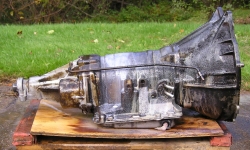 Thank goodness for pressure washers. This was a birthday present from my wife a couple years ago, it made relatively quick work of a nasty job.
Thank goodness for pressure washers. This was a birthday present from my wife a couple years ago, it made relatively quick work of a nasty job.
And, thanks to the nature of the job, I got a nice shower at the same time. Though it was rather cold and slimy. Yuck.
At least it was fairly warm for a mid-October day.
 Here again during the process.
Here again during the process.
Looking better already.
And...
 ...the finished product. Lots cleaner than when I started and minus
40 years of grease and grime.
...the finished product. Lots cleaner than when I started and minus
40 years of grease and grime.
What's left will get cleaned once it's on the bench for the rebuild.
 The serial number plate. Taffy Tan with the prefix PBS-63.
The serial number plate. Taffy Tan with the prefix PBS-63.
According to the shop manual, that indicates a 4BBL engine Star Chief and Bonneville series. But I already knew that. :-)
PAS-63 would have meant a Tri-Power (drool), or police 4BBL, while PES-63 would have been the economy 2BBL engine.
Let's Tear DOWN!
 Here's my new work space. Right now it's just an old fire door
mounted to some 2x's. But it's enough to get me started with tearing down the tranny.
Here's my new work space. Right now it's just an old fire door
mounted to some 2x's. But it's enough to get me started with tearing down the tranny.
In time, there'll be some cabinets above and probably below, along with some proper task lighting and pegboard for tools.
It ain't pretty but it works.
 Staring down the gullet of a Super Hydramatic 4 speed.
Staring down the gullet of a Super Hydramatic 4 speed.
The flywheel has been removed here. On the Super Hydramatic, the flywheel serves double duty as a torque converter cover.
Of course, you can tell that half the front torus (or torque converter) is removed too. So far things aren't looking too bad, why'd she stop working?
 Missing some pictures. Ran out of fresh batteries for the camera.
Missing some pictures. Ran out of fresh batteries for the camera.
The rest of the front torus, back cover, bell housing and rear torus have been removed by now. The pump cover is off as well. Nothing broken yet.
And certainly not what the tranny shop said was wrong with it. I guess they didn't really take it apart like they implied.
They didn't charge me, so I can't complain too much.
 Looking straight into the pump. It's got some surface rust, but then, it's been sitting without fluids for more than 3 years. This'll clean up fine.
Looking straight into the pump. It's got some surface rust, but then, it's been sitting without fluids for more than 3 years. This'll clean up fine.
 The first sign of a major problem. I doubt this is what caused the tranny's failure, but it doesn't make me feel any better either. This is the bushing
for the rear torus cover. It should be a nice, shiny bronze color, not a bluish-silvery copper.
The first sign of a major problem. I doubt this is what caused the tranny's failure, but it doesn't make me feel any better either. This is the bushing
for the rear torus cover. It should be a nice, shiny bronze color, not a bluish-silvery copper.
The manual says that if this shows the slightest sign of wear, the whole cover needs to be replaced. Thankfully, it seems it's still in production in the aftermarket, but for around 3 bills. Ouch.
 The tranny is upside down now. The front pump cover is back on temporarily, since I want to take it out as a unit. You can see the valve body here, as well.
The tranny is upside down now. The front pump cover is back on temporarily, since I want to take it out as a unit. You can see the valve body here, as well.
Missing is the filter assembly that I took off prior to putting it on the bench, and the servo/accumulator (shown below).
 Here's the servo and accumulator, out and stripped down. This showed some signs of wear and smelled of burnt transmission
fluid.
Here's the servo and accumulator, out and stripped down. This showed some signs of wear and smelled of burnt transmission
fluid.
Most of the wear appeared to be related to its two pistons and their rings, since there was a fine grayish paste all over the assembly and it seemed to be of the same material as the rings themselves.
Aside from that there doesn't seem to be any damage to it.
 The bottom of the transmission with everything but the shift and parking linkage removed.
The bottom of the transmission with everything but the shift and parking linkage removed.
 Here's a close up of the shift and parking linkage. This will stay in place throughout the rest of the rebuild since the manual says it should not be removed unless it is being replaced with new parts.
And so, since its not broken and I don't want to have to hunt down new parts, it stays.
Here's a close up of the shift and parking linkage. This will stay in place throughout the rest of the rebuild since the manual says it should not be removed unless it is being replaced with new parts.
And so, since its not broken and I don't want to have to hunt down new parts, it stays.
The cylindrical mass at the bottom of the photo is the rear unit. That comes out soon.
 The tail housing is gone now. Also removed, but hard to tell from the picture, are the governor assembly and its drive gear.
The tail housing is gone now. Also removed, but hard to tell from the picture, are the governor assembly and its drive gear.
Shown in the inset are my Craftsman snap ring pliers. Why? Because as cool as they looked in the catalog, they don't work that well and they aren't designed to remove the kind of retaining rings that comprise 90% of
those in this transmission.
I need to get a new pair/type of pliers before I go any further with major disassembly.
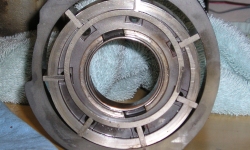 Here is a close-up of the pump's impeller removed from the pump. This is the same part shown 7 pictures above where I said it will clean up fine.
Here is a close-up of the pump's impeller removed from the pump. This is the same part shown 7 pictures above where I said it will clean up fine.
I may have spoken too soon.
Hard to tell from this shot (camera has a hard time getting in close), but the channel around the center bushing shows signs of galling.
Hmmm... If the pump is messed up, would that prevent the tranny from working? Yeah, probably.
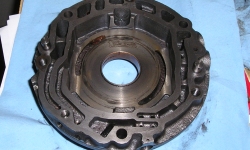 This is the pump where the impeller sits. Basically, the other side of the impeller sits on this surface. More galling and gouges present.
More money if I need a new pump like I imagine I will.
This is the pump where the impeller sits. Basically, the other side of the impeller sits on this surface. More galling and gouges present.
More money if I need a new pump like I imagine I will.
Hopefully I can get one, as I haven't specifically seen these available.
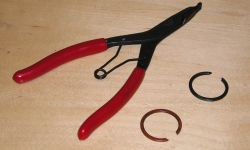 Here are my new lock-ring pliers, purchased from the Mac Tools website, along with a couple of the lock-rings I was having such a hard time removing
with my snap-ring pliers.
Here are my new lock-ring pliers, purchased from the Mac Tools website, along with a couple of the lock-rings I was having such a hard time removing
with my snap-ring pliers.
Yeah, yeah, I know... Right tool for the right job.
These are actually two of the three rings I had to remove to get the rear unit out of the case. The first one took close to 10 minutes to get out with the old pliers. Less than three for the last two with the new ones. :-/
 The rear unit, neutral clutch and case support. This took quite a number of whacks with a rubber mallet to release from the trans housing (hitting the
end of the tail shaft as directed by the manual).
The rear unit, neutral clutch and case support. This took quite a number of whacks with a rubber mallet to release from the trans housing (hitting the
end of the tail shaft as directed by the manual).
As soon as I got it released from the case I heard a un-natural sound which will be explained below.
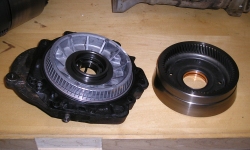 And here's the reverse clutch housing and piston (left) and the reverse internal gear (right).
And here's the reverse clutch housing and piston (left) and the reverse internal gear (right).
These came off the back of the case once the rear unit was removed.
There are a couple issues with this unit
 Problem Number 1.
Problem Number 1.
Here is a close up of the bushing from the reverse internal gear. It is exhibiting signs of uneven wear and a couple of gouges in its surface. The gouges probably got there during disassembly, but the uneven wear is obviously from operation.
Once again, the manual says this bushing should show no signs of wear. There goes the parts bill again. Ka-CHING!
 Problem Number 2.
Problem Number 2.
This is the source of the un-natural sound mentioned above. It basically settled into the bottom of the case as the rear unit moved forward.
I'm pretty sure this is supposed to be one continuous ring of metal. As a matter of fact, it should have five evenly space waves about 1/4" deep.
Fatsco is gonna LOVE hearing from me.